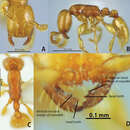en
names in breadcrumbs


Aenictus Shuckard, 1840: 266.
Typhlatta Smith, 1857: 79 (synonym of Aenictus by Forel, 1890: ciii; removed from synonymy as subgenus of Aenictus by Wheeler,1930: 198; synonym of Aenictus by Wilson, 1964: 444).
Diagnosis. Workers of Aenictus may be separated from other Australian ants by their moderately small size (less than about 4 mm), lack of eyes, long slender bodies and long legs. They are superficially similar to some myrmicines but differ in lacking the frontal lobes and in having the antennal sockets completely visible when viewed from the front (myrmicines have frontal lobes that are expanded towards the sides of the head and partly cover the antennal sockets). Some of the smaller, paler species are also similar to Leptanilla workers, but differ in being larger and only ten segments in the antennae rather than 12, and lacking a flexible promesonotal suture.
Males of Aenictus can be separated from those of other Australian ants by the exposed antennal sockets and lack of a postpetiole (the gaster is smooth and lacks a constriction between the first and second segments).
Key to Species of Australian Aenictus based on workers
1. A ridge (parafrontal ridge) present on the front of the head starting between the antennal and mandibular insertions and extending posteriorly; head capsule varying from smooth posteriorly and weakly punctate between the frontal carinae and above the mandibular insertions to completely punctuate ...................... 2
- Area between antennal and mandibular insertions smooth or at most slightly angular but never ridged (parafrontal ridge absent); head capsule entirely smooth ........................................................................... 4
2. Pronotum with large smooth areas dorsally and laterally, other areas micro-reticulate............. philiporum
- Pronotum entirely sculptured with dense micro-reticulations ....................................................................3
3. Scape relatively long (SI> 107)...................................................................................................... nesiotis
Scape relatively short (SI <103)........................................................................................................ aratus
4. Head with large pale patches near the posterolateral corners; subpetiolar process generally absent but sometimes present as a slight carina................................................................................................. diclops
Head essentially uniform in colour; subpetiolar process large and rectangular .........................................5
5. Scape relatively long (SI> 89)........................................................................................................ prolixus
Scape relatively short (SI <91) .................................................................................................................. 6
6. Body larger (HW> 0.62mm); sculpturing on pronotum extending posteriorly onto the main pronotal body .......................................................................................................................................................... acerbus
- Body smaller (HW <0.62mm); sculpturing on pronotum limited to the anterior sections around the collar, the main body of pronotum smooth................................................................................................. turneri